Portable terminal having a wireless charger coil and an antenna element on the same plane
Park , et al. December 30, 2
U.S. patent number 8,922,162 [Application Number 13/312,359] was granted by the patent office on 2014-12-30 for portable terminal having a wireless charger coil and an antenna element on the same plane. This patent grant is currently assigned to Samsung Electronics Co., Ltd. The grantee listed for this patent is Ki-Hyun Kim, Kil-Soo Ko, Jin-Hyoung Park, Se-Ho Park, Sung-Kweon Park. Invention is credited to Ki-Hyun Kim, Kil-Soo Ko, Jin-Hyoung Park, Se-Ho Park, Sung-Kweon Park.
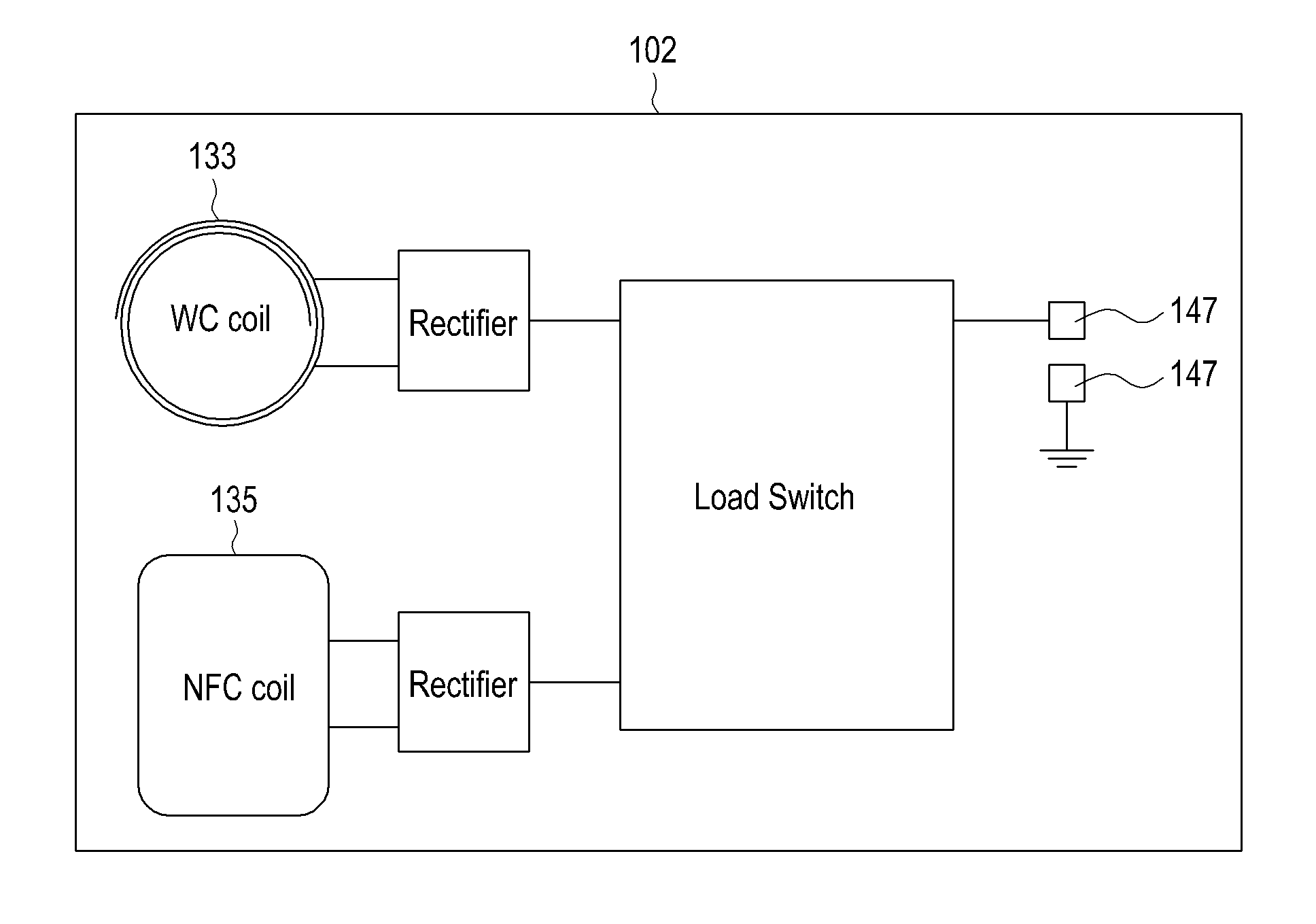
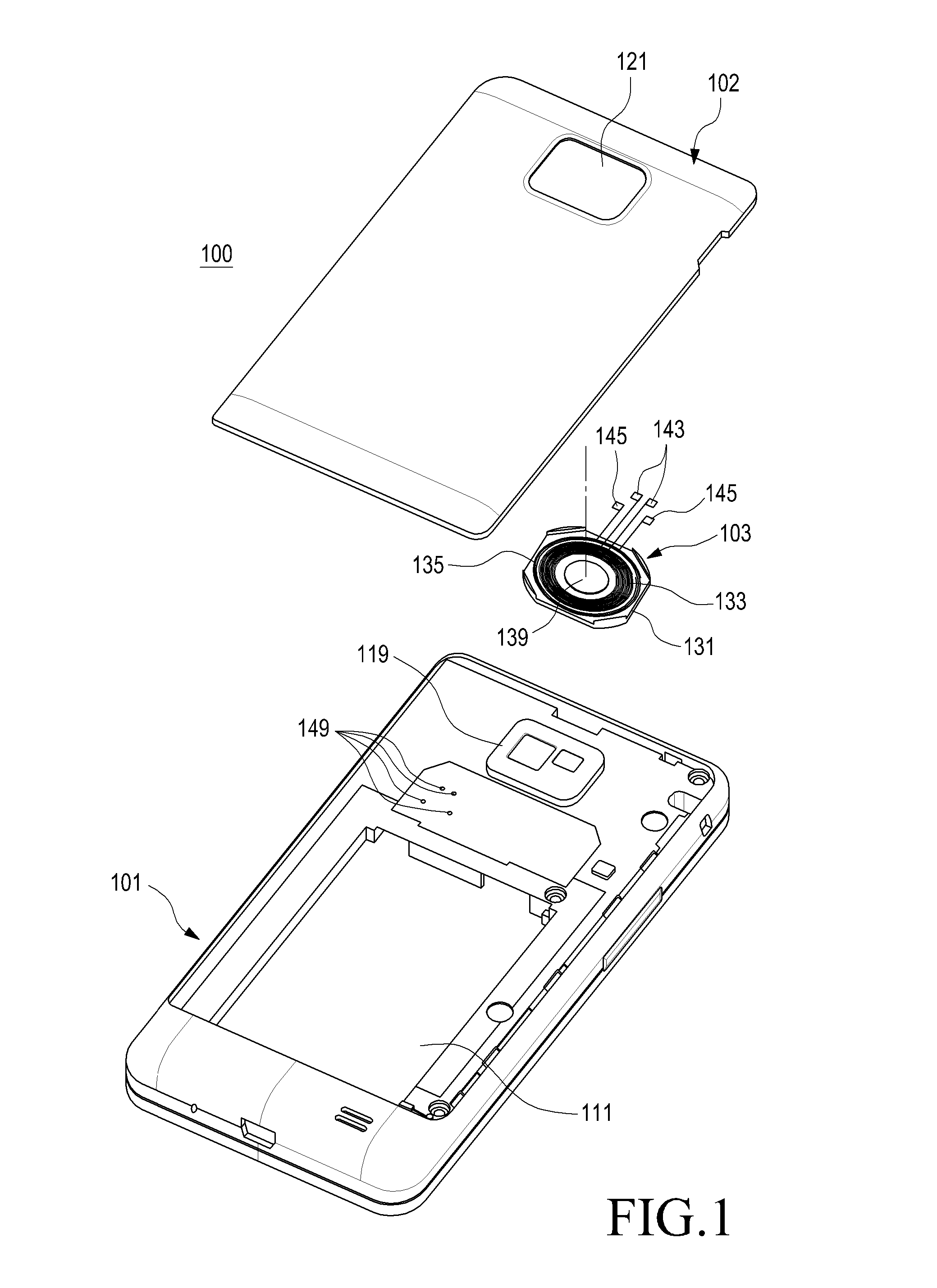
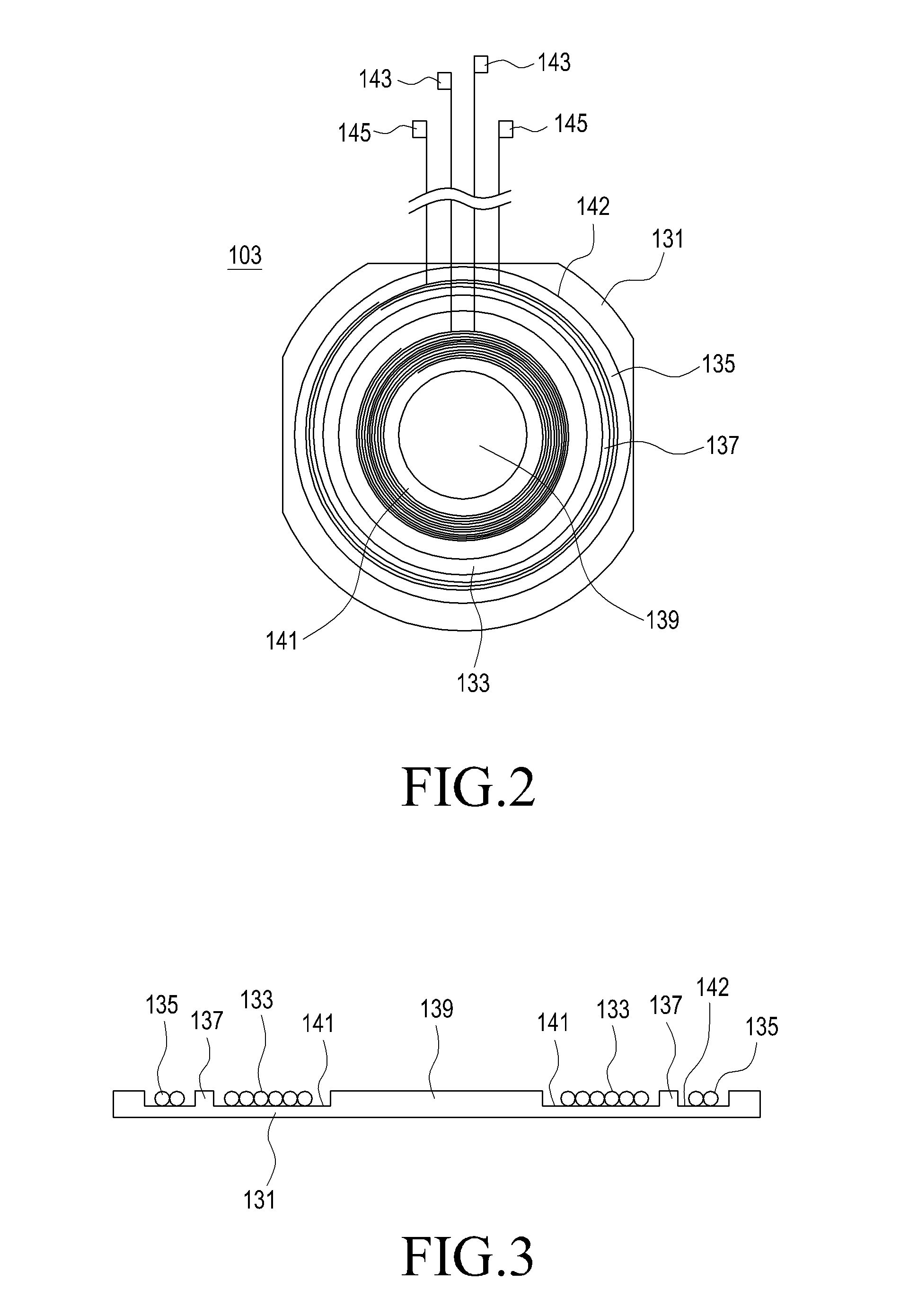
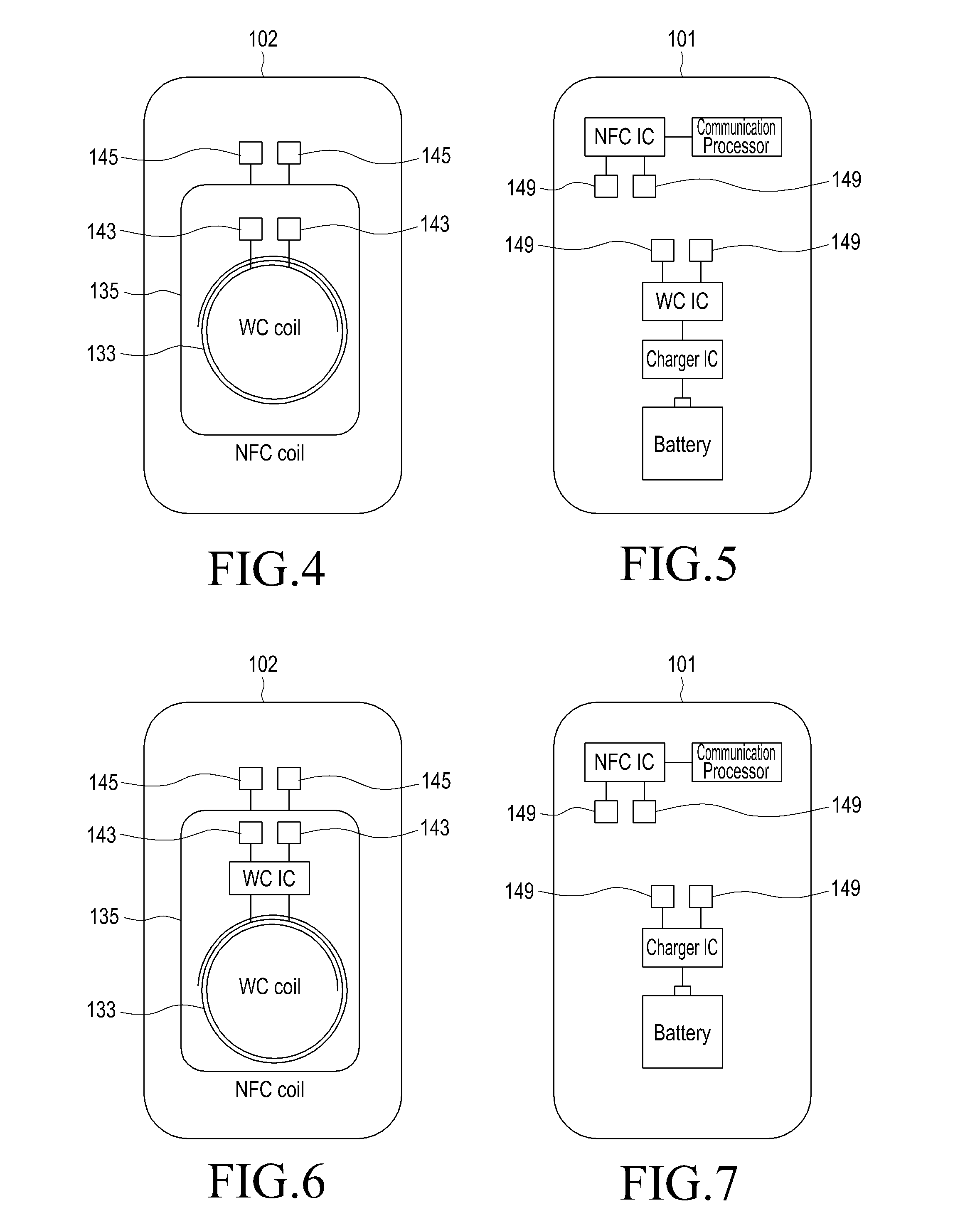
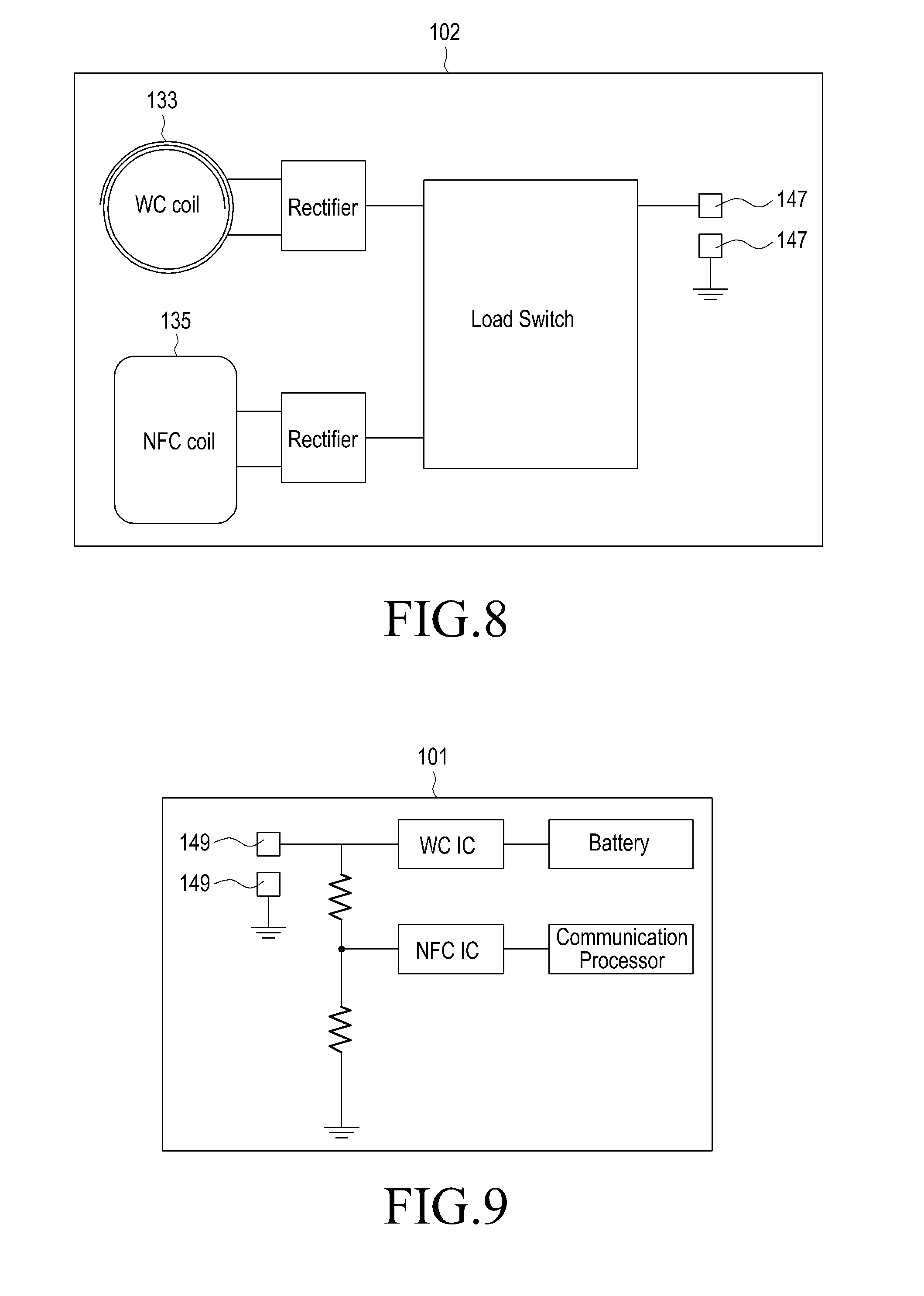
| United States Patent | 8,922,162 |
| Park , et al. | December 30, 2014 |
Portable terminal having a wireless charger coil and an antenna element on the same plane
Abstract
A portable terminal having a wireless charger coil and an antenna element on the same plane is provided, in which a shielding member is attached to an inner surface of an external part, a first coil is attached to one surface of the shielding member, facing the inner surface of the external part, and a second coil is attached to the one surface of the shielding member, surrounding the first coil on the same plane.
| Inventors: | Park; Jin-Hyoung (Gangwon-do, KR), Kim; Ki-Hyun (Gyeonggi-do, KR), Ko; Kil-Soo (Gyeonggi-do, KR), Park; Se-Ho (Gyeonggi-do, KR), Park; Sung-Kweon (Gyeonggi-do, KR) | ||||||||||
|---|---|---|---|---|---|---|---|---|---|---|---|
| Applicant: |
|
||||||||||
| Assignee: | Samsung Electronics Co., Ltd
(KR) |
||||||||||
| Family ID: | 47677139 | ||||||||||
| Appl. No.: | 13/312,359 | ||||||||||
| Filed: | December 6, 2011 |
Prior Publication Data
| Document Identifier | Publication Date | |
|---|---|---|
| US 20130038278 A1 | Feb 14, 2013 | |
Foreign Application Priority Data
| Aug 8, 2011 [KR] | 10-2011-0078611 | |||
| Current U.S. Class: | 320/108 |
| Current CPC Class: | H01F 38/14 (20130101); H02J 7/04 (20130101); H02J 7/00 (20130101); H02J 50/90 (20160201); H04B 5/0081 (20130101); H04M 1/0262 (20130101); H04W 88/02 (20130101); H04B 5/0087 (20130101); H02J 7/0044 (20130101); H04B 5/00 (20130101); H02J 50/10 (20160201); H04B 5/0037 (20130101); H04B 5/0075 (20130101); H04M 2250/04 (20130101) |
| Current International Class: | H01M 10/46 (20060101) |
| Field of Search: | ;320/107,108,114,115 |
References Cited [Referenced By]
U.S. Patent Documents
| 2011/0050164 | March 2011 | Partovi et al. |
| 2012/0146576 | June 2012 | Partovi |
Attorney, Agent or Firm: The Farrell Law Firm, P.C.
Claims
What is claimed is:
1. A portable terminal comprising: a shielding member attached to an inner surface of an external part; a first coil attached to a surface of the shielding member that faces the inner surface of the external part; a second coil attached to the surface of the shielding member, wherein the second coil surrounds the first coil on a same plane; and a load switch providing a first connection line for connecting the first coil to a battery pack of the portable terminal and a second connection line for connecting the second coil to a communication circuit of the portable terminal, wherein the load switch prevents signal or power interference between the first connection line and the second connection line.
2. The portable terminal of claim 1, wherein the first coil is a secondary coil for inductive coupling with a charger and the second coil is an antenna element.
3. The portable terminal of claim 1, wherein the first coil is an antenna element and the second coil is a secondary coil for inductive coupling with a charger.
4. The portable terminal of claim 1, further comprising a battery mounting recess formed on a housing of the portable terminal, wherein the external part is a battery cover detachably engaged with the housing, for opening or covering the battery mounting recess.
5. The portable terminal of 1, wherein a battery pack connected to the first coil is accommodated in the portable terminal and the first coil is a secondary coil for inductive coupling with a charger, connected to the battery pack.
6. The portable terminal of claim 1, wherein the second coil is a Near Field Communication (NFC) antenna element.
7. The portable terminal of claim 1, further comprising an NFC control circuit built in the portable terminal, wherein one of the first and second coils is connected to a communication circuit of the portable terminal through the NFC control circuit.
8. The portable terminal of claim 1, further comprising a wireless charging control circuit built in the external part or the portable terminal, wherein one of the first and second coils is connected to a battery pack of the portable terminal via the wireless charging control circuit.
9. The portable terminal of claim 1, further comprising a magnetic piece attached to the surface of the shielding member, in an area surrounded by the first coil.
10. A portable terminal comprising: a shielding member attached to an inner surface of an external part; a first coil attached to a surface of the shielding member that faces the inner surface of the external part; and a second coil attached to the surface of the shielding member, wherein the second coil surrounds the first coil on a same plane, wherein the shielding member comprises: a first accommodation groove formed into the surface of the shielding member; and a second accommodation groove surrounding the first accommodation groove on the surface of the shielding member, wherein the first coil is accommodated in the first accommodation groove and the second coil is accommodated in the second accommodation groove.
11. The portable terminal of claim 10, wherein the shielding member further comprises a protrusion portion formed of a paramagnetic material, surrounded by the first accommodation groove.
12. The portable terminal of claim 10, further comprising a magnetic piece formed of a paramagnetic material, attached to an area surrounded by the first accommodation groove.
13. The portable terminal of claim 10, wherein the shielding member further comprises a shielding wall between the first and second accommodation grooves.
14. The portable terminal of claim 10, wherein the shielding member is formed by injection-molding a mixture of an iron powder and synthetic resin.
15. The portable terminal of claim 14, wherein the synthetic resin is one of Poly Carbonate (PC), Poly Amide (PA), Acrylonitrile-Butadiene-Styrene (ABS) copolymer, and Nylon.
Description
PRIORITY
This application claims priority under 35 U.S.C. .sctn.119(a) to a Korean Patent Application filed in the Korean Intellectual Property Office on Aug. 8, 2011, and assigned Serial No. 10-2011-0078611, the contents of which are incorporated herein by reference.
BACKGROUND OF THE INVENTION
1. Field of the Invention
The present invention relates to a portable terminal, and more particularly, to a portable terminal having a secondary coil for wireless charging, as well as a plurality of antenna elements.
2. Description of the Related Art
In general, a portable terminal is a device capable of performing a mobile communication function, an electronic note function, Internet access, and a multimedia function, among other functions, while being carried by a user. Recently, various functions have been integrated in a single mobile communication terminal called a smart phone.
Meanwhile, a transport card, a security card, a credit card, and the like can be used to make payment or to authenticate a user by a Near Field Communication (NFC) function. As portable terminals have become a daily commodity, they are equipped with the NFC function. Accordingly, a portable terminal is provided with an additional antenna for performing the NFC function. Compared to short-range wireless communication, such as Bluetooth.TM. or Zigbee.TM. functions, the NFC technology provides an advantage of fast communication setup between communication devices. Despite this advantage, the NFC function communicates at a relatively low frequency of 13.56 MHz, making it important to be within recognition distance to implement the NFC function in a portable terminal.
To supply power to the portable terminal, a detachable battery pack or a built-in battery pack is used. A user charges the battery pack according to the remaining amount of battery power, generally, using a separate charger. To increase user convenience, efforts have been made to commercialize wireless charging. For wireless charging, inductive coupling using a magnetic field, capacitive coupling using an electrical field, and radio frequency wave radiation are available. Among them, the inductive coupling scheme is suitable for wireless charging in terms of power efficiency. According to the inductive coupling scheme, a battery pack is wirelessly charged by aligning a primary coil of a charger with a secondary coil of a portable terminal.
To implement both the NFC function and the wireless charging function in a single portable terminal, an NFC antenna element taking the form of a loop antenna and a secondary coil for wireless charging should be mounted in the portable terminal. A shielding body is used to prevent interference between the antenna element and the secondary coil, and to protect from interference caused by the secondary coil on other circuits of the portable terminal when the antenna element and the secondary coil simultaneously operate. However, the use of a shielding body for each of the antenna element and the secondary coil increases the thickness of the portable terminal. Although the secondary coil for wireless charging may be utilized as the NFC antenna element, it is difficult to achieve both wireless charging efficiency and a recognition distance for NFC. Moreover, since the shielding body is usually formed by rolling to be in a planar form, it is difficult to fix a spirally wound coil or an antenna element having the same structure.
SUMMARY OF THE INVENTION
An aspect of embodiments of the present invention is to address at least the problems and/or disadvantages and to provide at least the advantages described below. Accordingly, an aspect of embodiments of the present invention is to provide a portable terminal having a structure that facilitates mounting of a secondary coil for wireless charging and a Near Field Communication (NFC) antenna element, without increasing the thickness of the portable terminal.
Another aspect of embodiments of the present invention is to provide a portable terminal having a structure that can achieve a sufficient wireless charging efficiency and a sufficient recognition distance for NFC.
A further aspect of embodiments of the present invention is to provide a portable terminal having a structure that facilitates fixing of a spirally wound coil or an antenna element having the same configuration as the coil.
In accordance with an embodiment of the present invention, there is provided a portable terminal in which a shielding member is attached to an inner surface of an external part, a first coil is attached to a surface of the shielding member that faces the inner surface of the external part, and a second coil is attached to the surface of the shielding member, with the second coil surrounding the first coil on a same plane.
BRIEF DESCRIPTION OF THE DRAWINGS
The above and other objects, features and advantages of certain embodiments of the present invention will be more apparent from the following detailed description taken in conjunction with the accompanying drawings, in which:
FIG. 1 is an exploded perspective view of a portable terminal according to an embodiment of the present invention;
FIG. 2 is a plan view of a coil module in the portable terminal of FIG. 1;
FIG. 3 is a sectional view of the coil module of FIG. 2;
FIG. 4 illustrates mounting of the coil module of FIG. 2 to a battery cover of the portable terminal according to an embodiment of the present invention;
FIG. 5 illustrates the portable terminal with which the battery cover illustrated in FIG. 4 is combinable;
FIG. 6 illustrates mounting of the coil module of FIG. 2 to the battery cover of the portable terminal according to another embodiment of the present invention;
FIG. 7 illustrates the portable terminal with which the battery cover illustrated in FIG. 6 is combinable;
FIG. 8 illustrates mounting of the coil module of FIG. 2 to the battery cover of the portable terminal according to a further embodiment of the present invention; and
FIG. 9 illustrates the portable terminal with which the battery cover of FIG. 8 is to be combined.
DETAILED DESCRIPTION OF EMBODIMENTS OF THE INVENTION
Reference will now be made in detail to embodiments of the present invention with reference to the accompanying drawings. In the drawings, the same reference numerals will be understood to refer to the same elements, features and structures. In addition, a detailed description of a generally known function and structure of the present invention will be avoided lest it should obscure the subject matter of the present invention.
Referring to FIGS. 1-3, a portable terminal 100 according to an embodiment of the present invention includes a shielding member 131 attached to an inner surface of an external part such as a battery cover 102 or a housing 101, and a pair of coils 133 and 135 attached to the shielding member 131. The coils 133 and 135 are mounted on the same plane. The shielding member 131 and the coils 133 and 135 are collectively referred to herein as a coil module 103.
Referring to FIG. 1, the portable terminal 100 is a bar type terminal having a touch screen display. While not shown, the display, function keys such as Start/End and Select keys, a transmitter, and a receiver are installed on a front surface of the housing 101.
The housing 101 is provided on a rear surface of the portable terminal 100, with a battery mounting recess 111 for accommodating a battery pack. The battery cover 102 covers the battery mounting recess 111. A plurality of terminals 149 and a camera module 119 are installed at one side of the battery mounting recess 111, with the terminals 149 also being covered by the battery cover 102. An opening 121 penetrates through both surfaces of the battery cover 102. The camera module 119 is accommodated in the opening 121, thereby securing a capturing path. A connector terminal, a memory slot, a volume key, and a camera shutter switch (not shown) may be arranged on a side surface of the housing 101.
The coil module 103 is attached to the inner surface of the battery cover 102 and connected to circuits of the portable terminal 100, for example, a communication circuit or a charging circuit via the plurality of terminals 149. As illustrated in FIGS. 1-3, the coil module 103 includes the shielding member 131 and the coils 133 and 135.
The shielding member 131 may be formed by injection molding, having first and second accommodation grooves 141 and 142 on a surface thereof. The first and second accommodation grooves 141 and 142 are circular in shape and recessed into one surface of the shielding member 131. The second accommodation groove 142 surrounds the first accommodation groove 141, being concentric with the first accommodation groove 141. A shielding wall 137 is interposed between the first and second accommodation grooves 141 and 142.
A pellet being a mixture of metal powder containing an iron (Fe) component and synthetic resin is injection-molded into the shielding member 131. The synthetic resin is preferably Poly Carbonate (PC), Poly Amide (PA), Acrylonitrile-Butadiene-Styrene (ABS) copolymer, or Nylon. As stated above, the shielding member 131 contains the iron component which prevents mutual interference between the coils 133 and 135, and prevents the coils 133 and 135 from impacting circuits within the portable terminal 100, caused by electronic waves generated from high-frequency waves, low-frequency waves, or power applied to the coils 133 and 135.
As shown in FIGS. 2-3, the first coil 133 is accommodated in the first accommodation groove 141 and the second coil 135 is accommodated in the second accommodation groove 142. The first and second coils 133 and 135 are formed by spirally winding enamel-insulated conductor wires.
As the first and second coils 133 and 135 are accommodated in the first and second accommodation grooves 141 and 142, respectively, and the second coil 135 surrounds the first coil 133. Herein, the shielding wall 137 between the first and second coils 133 and 135 provides a shielding effect between the coils. In other words, the shielding wall 137 shields interference of electronic waves between the first and second coils 133 and 135. The first and second coils 133 and 135 have connection ends 143 and 145, respectively, extended from one side of the shielding member 131. The connection ends 143 and 145 are connected to circuits of the portable terminal 100 via the plurality of terminals 149 provided on the housing 101.
When installed, the first and second coils 133 and 135 are exposed from one surface of the shielding member 131. However, the first and second coils 133 and 135 face the inner surface of the battery cover 102 when the shielding member 131 is attached to the battery cover 102, thereby covering the first and second coils 133 and 135. Consequently, the first and second coils 133 and 135 are covered by the shielding member 131 and the battery cover 102.
One of the first and second coils 133 and 135 may be used as a secondary coil for wireless charging and the other coil may be used as an NFC antenna element. The coils 133 and 135 may also be used as antennas for short-range wireless communication, e.g. Bluetooth.TM. or terrestrial multimedia broadcasting antennas, the embodiments of the present invention utilize the first coil 133 as a secondary coil for wireless charging and utilize the second coil 135 as an NFC antenna element.
For wireless charging, the portable terminal 100 may be cradled on a charging cradle (not shown) to align a primary coil of a charger with the secondary coil of the portable terminal 100 corresponding to the first coil 133. Alternatively, the primary coil is movably mounted in the charging cradle such that when the portable terminal 100 is positioned on the charging cradle, the primary coil is moved to align with the portable terminal 100.
To align the primary coil of the charging cradle with the first coil 133 of the portable terminal 100, the shielding member 131 may have a protrusion portion 139. The protrusion portion 139 protrudes from the first accommodation groove 141 of the shielding member 131. Since the shielding member 131 contains the iron component, the protrusion portion 139 also contains an iron component. That is, because the protrusion portion 139 contains a paramagnetic material, i.e. the iron component, when the protrusion portion 139 is positioned within the magnetic field of a permanent magnet, an attraction force of the permanent magnet pulls on the protrusion portion 139.
The permanent magnet is attached to the primary coil of the charging cradle. When the portable terminal 100 is mounted on the charging cradle, the attraction force between the permanent magnet and the shielding member 131, particularly the protrusion portion 139, aligns the primary coil of the charging cradle with the first coil 133 of the portable terminal 100. Meanwhile, while the protrusion portion 139 contains the iron component and thus has a paramagnetic property, the protrusion portion 139 may have an additional magnetic portion attached on the first accommodation groove 141 to increase the attraction force between the permanent magnet of the primary coil and the shielding member 131. Preferably, the additional magnetic portion is formed of a paramagnetic material.
FIGS. 4 to 9 illustrate configurations of a portable terminal that implements both a wireless charging function and an NFC function using the coil module 103, with the first coil 133 as a secondary coil used for wireless charging and the second coil 135 as an antenna element for NFC, by way of example.
FIG. 4 illustrates mounting of the coil module 103 on the battery cover 102 of the portable terminal 100 according to an embodiment of the present invention and FIG. 5 illustrates the housing 101 to be combined with the battery cover 102 illustrated in FIG. 4.
FIG. 6 illustrates mounting of the coil module 103 on the battery cover 102 of the portable terminal 100 according to another embodiment of the present invention and FIG. 7 illustrates the housing 101 to be combined with the battery cover 102 illustrated in FIG. 6.
To implement the wireless charging function and the NFC function using the first and second coils 133 and 135, the first and second coils 133 and 135 are connected to a communication processor and a charge Integrated Circuit (IC), respectively. An NFC IC or a Wireless Charger (WC) IC is disposed on a connection of the first or second coil 133 or 135 to a circuit of the portable terminal 100. These ICs control current and voltage during charging.
In accordance with the embodiment of the present invention illustrated in FIGS. 4 and 5, the NFC IC is connected to the communication processor of the portable terminal 100 and to the second coil 135 mounted to the battery cover 102 via the plurality of terminals 149. The charger IC is installed inside the portable terminal 100 and connected to the battery pack. In addition, the WC IC is connected to the charger IC inside the portable terminal 100 and to the first coil 133 mounted to the battery cover 102 through the remaining plurality of terminals 149.
The embodiments illustrated in FIGS. 4 and 5 and in FIGS. 6 and 7 are substantially identical in configuration, except that the WC IC is installed to the battery cover 102 in the latter embodiment. Thus further detail of the embodiment illustrated in FIGS. 6 and 7 is not repeated herein.
FIG. 8 illustrates mounting of the coil module 103 on the battery cover 102 of the portable terminal 100 according to a further embodiment of the present invention, and FIG. 9 illustrates the housing 101 to be combined with the battery cover 102 of FIG. 8.
Referring to FIGS. 8 and 9, the first and second coils 133 and 135 share connection ends 147 and only a pair of terminals 149 are installed on the housing 101. In this case, even though power is supplied and signals are transmitted through the shared connection ends 147 and the pair of terminals 149, a load switch may prevent signal or power interference on lines. Since more power is supplied through a line during wireless charging than during powering of a signal for the NFC function, the load switch prevents the wireless charging power from influencing the NFC line or the second coil 135.
As illustrated in FIGS. 4 to 9, those of skill in the art will recognize that a rectifier or a charger IC can be selectively disposed in connecting the first and second coils 133 and 135 configured as a secondary coil for wireless charging and an antenna element for the NFC function to circuits of the portable terminal 100.
When the wireless charging function and the NFC function are implemented using the coil module of the present invention, approximately 71% power efficiency can be achieved during wireless charging and a recognition distance of about 25 mm can be secured for the NFC function. As the first and second coils are positioned on a same plane, the increase of the thickness of the portable terminal is minimized and both the wireless charging function and the NFC function can be implemented in a single terminal.
As is apparent from the above description, the portable terminal according to the present invention has a first coil for wireless charging and a second coil for the NFC function on the same plane. Therefore, both the wireless charging function and the NFC function can be implemented in the portable terminal without increasing the thickness of the portable terminal. Since grooves for accommodating the first and second coils are formed in a shielding member, spirally wound first and second coils can be readily fixed herein. Furthermore, a shielding wall being a part of the shielding member isolates the first and second coils from each other, thereby preventing mutual interference between the first and second coils. As a consequence, high power efficiency and a sufficient recognition distance can be achieved for the wireless charging function and the NFC function, respectively.
While the present invention has been particularly shown and described with reference to embodiments thereof, it will be understood by those of ordinary skill in the art that various changes in form and details may be made therein without departing from the spirit and scope of the present invention as defined by the following claims.
* * * * *
D00000

D00001

D00002

D00003

D00004

XML
uspto.report is an independent third-party trademark research tool that is not affiliated, endorsed, or sponsored by the United States Patent and Trademark Office (USPTO) or any other governmental organization. The information provided by uspto.report is based on publicly available data at the time of writing and is intended for informational purposes only.
While we strive to provide accurate and up-to-date information, we do not guarantee the accuracy, completeness, reliability, or suitability of the information displayed on this site. The use of this site is at your own risk. Any reliance you place on such information is therefore strictly at your own risk.
All official trademark data, including owner information, should be verified by visiting the official USPTO website at www.uspto.gov. This site is not intended to replace professional legal advice and should not be used as a substitute for consulting with a legal professional who is knowledgeable about trademark law.